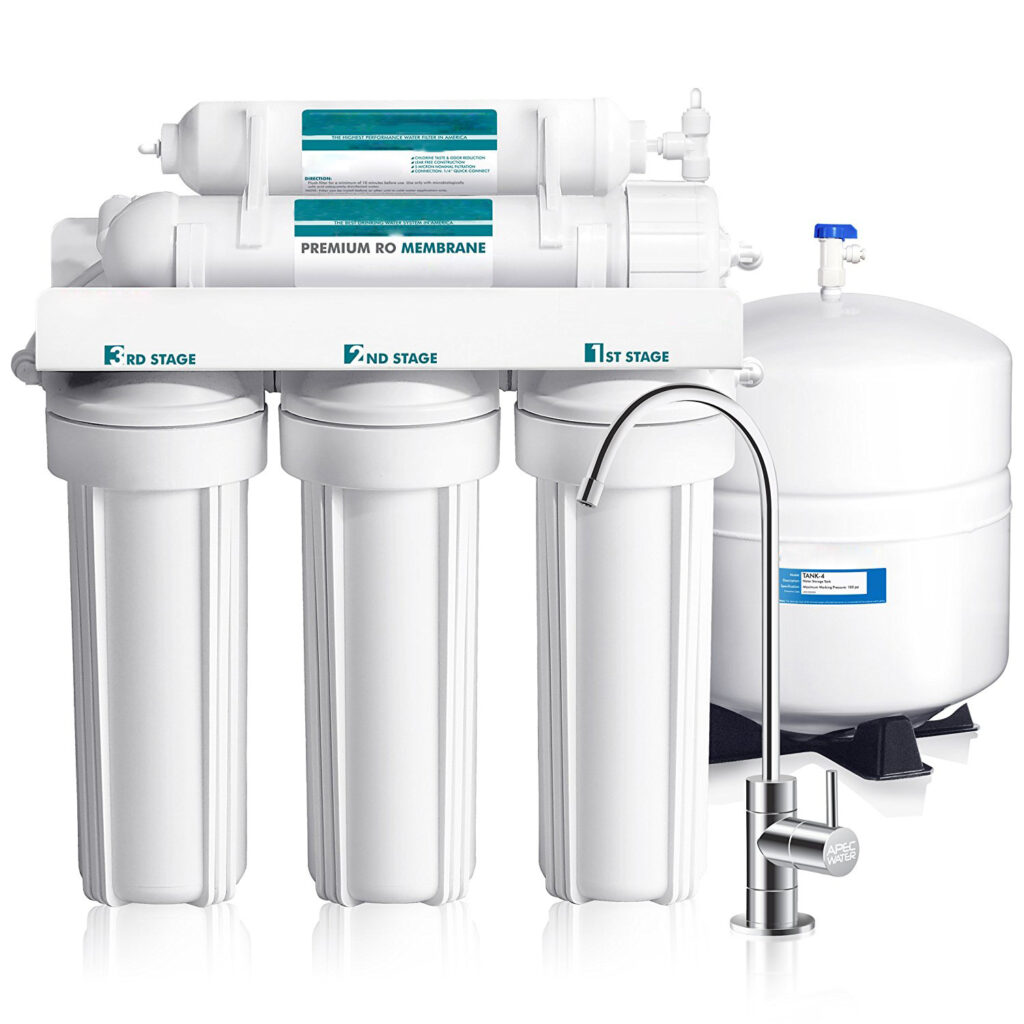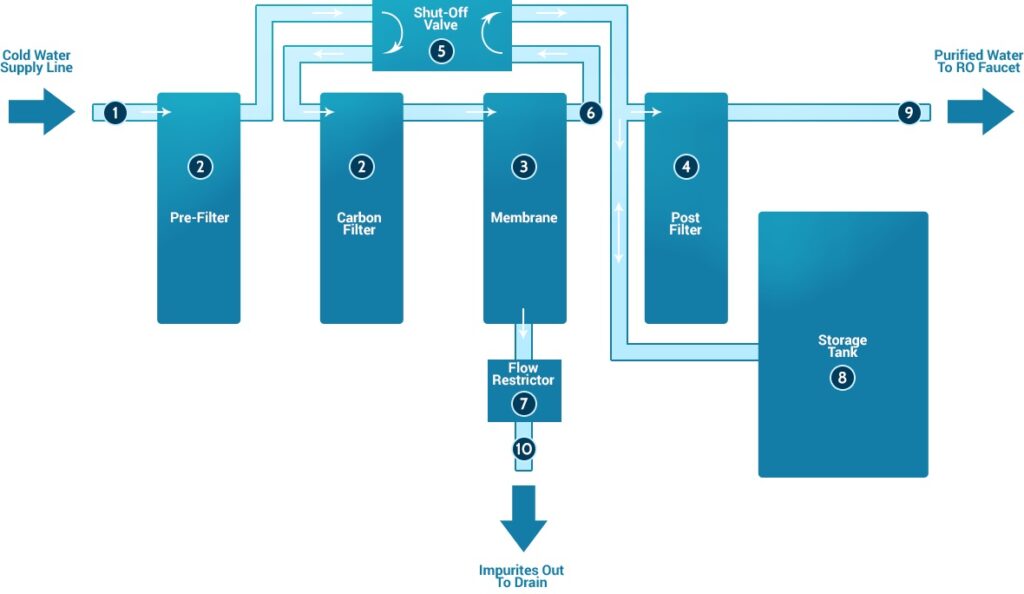Reverse Osmosis Filters have often been promoted as probably the best sort of filters available. From promising a great tasting water to remove the impurities, you would probably be thinking if there is anything a Reverse Osmosis Filter cannot do. Right?
And they were keeping in mind that Reverse Osmosis Filters are an extremely robust technique for filtering numerous sorts of unwanted substances and pollutants from water. They also have circumstances where they stand out and others where various kinds of filtration may give better water results.
What is Reverse Osmosis?

Reverse Osmosis removes unwanted substances from unfiltered water or feedwater when the pressure forces it through a semipermeable layer. Water streams from the concentrated side of the RO layer to the less concentrated side (lesser toxins) to give clean drinking water. The freshwater delivered is known as the saturate. The concentrated water left over is known as the waste or saline solution.
A semipermeable membrane has tiny pores that block toxins yet permit water particles to course through. In Osmosis, the water turns out to be more concentrated as it goes through the membrane to achieve an equilibrium on both sides. Reverse Osmosis, be that as it may, blocks unwanted substances from entering the less concentrated side of the layer.
For instance, when the pressure is applied to a volume of saltwater during reverse Osmosis, the salt is left out, and just clean water moves through.
How does a Reverse Osmosis Filter work?

A Reverse Osmosis filter removes the filth and chlorine from water with a prefilter before it moves water through a semipermeable layer to remove the dissolved materials. After the water leaves the Reverse Osmosis layer, it is a postfilter to clean the drinking water before it reaches you. Reverse Osmosis systems have different stages relying upon their number of prefilters and post-filters.
The Stages of Reverse Osmosis Systems:
The Reverse Osmosis layer is the point of convergence of a reverse osmosis system. However, a Reverse Osmosis system also includes different kinds of filtration. The Reverse Osmosis systems are comprised of 3, 4, or 5 stages of filtration.
Each Reverse Osmosis water filter contains a residue filter and a carbon filter along with the RO membrane. The filters are called either prefilters or post-filters. It is dependent upon whether water goes through them before or after it goes through the membrane.
No matter how different the Reverse Osmosis Filter is, a few commonly found membranes are:
Sediment Filter: Eliminates substances like dirt, dust, and rust.
Carbon Filter: Diminishes Volatile Organic Compounds (VOCs), chlorine, and different impurities that give water an awful taste or smell.
Semi-porous Film: Removes up to 98% of Total Dissolved Solids (TDS).
Step 1: When the water first enters a Reverse Osmosis or RO system, it goes through a pre-filtration process. A pre-filtration process includes a carbon filter and a sediment filter typically to remove silt and chlorine, hindering or harming the RO layer.
Step 2: Then, water goes through the Reverse Osmosis layer where the particles that cannot be seen with the naked eyes, mostly dissolved particles, are removed.
Step 3: After filtration, water streams through the storage tank, where it is held until required. A Reverse Osmosis system keeps on filtering water until the storage tank is full and afterwards shuts off.
Step 4: When you turn on your drinking water faucet, the water comes from the storage tank through a postfilter to clean drinking water before it gets to your tap.
Well, that was all about the working of a Reverse Osmosis Filter. You all might be wondering if you really need one too? Let us help you figure that out.
Why Do You Need A Reverse Osmosis Filter?
A few reasons why you must get a Reverse Osmosis Filter are explained below:
Great for the Environment:
A plenty of us are guilty about having bought a plastic water bottle. Despite the fact that we know how awful this is for the planet, now and then, the comfort exceeds that thought. If you use a Reverse Osmosis (RO) filter to get fresh, clean water directly from your tap, you will not be considering getting a plastic bottle to harm the mother nature.
Likewise, Reverse Osmosis systems use significantly less energy than the other methods to filter water. Hence, it is an amazing alternative.
Better Tasting Water:
It does not need any rocket science or some advanced degree in Chemistry to understand that removing these impurities and these pollutants will result in cleaner and better-tasting water. You might have a sip of water and not say, “This water tastes like lead.” However, you might be able to taste the chlorine or some other contaminants.
Indeed a lot of people become acclimated to the flavour of their tap water after some time. At the point when they initially have a glass of water of RO filtered water, it may taste “bad” to them.
Varied Health Benefits:
Among different pollutants that Reverse Osmosis filters eliminate are microbes and different kinds of microorganisms. We all need water that is extremely clean and contamination-free. This is especially needed for people who are undergoing a chemotherapy session or something and for people with a compromised immune system.
Again, it isn’t just solely limited to people with a weaker immune system. All things considered, everybody is in danger from lead and cryptosporidium parasites, just to name two potential contaminants of conventional tap water. Lead has been proven to be hazardous to the human body. Cryptosporidium parasites can prompt fever, diarrhoeas, and cramps.
Moreover, Reverse Osmosis or RO Filters remove sodium from the water. And a lot of you might even know that most of the foods that we consume have a lot of sodium in them. We definitely do not need more in the water we drink. A low sodium consumption helps in minimizing the risk of kidney disease, high blood pressure, liver issues and so on.
Saves Money:
With a Reverse Osmosis Filter in your home, you will continually get access to cleaner, better-tasting water. This implies fewer outings to the store and no money spent on single-use water bottles and filters for refillable pitchers. By putting money into a RO Filter, you are not only just saving a lot of money but also a lot of time. Trench the outings to the store and basically turn on your tap to drink, clean or cook with water you can rely upon.
What Does a Reverse Osmosis or RO Filter Remove?
A Reverse Osmosis system removes the dissolved solids like arsenic and fluoride through the RO membrane. A RO Filter also incorporates residue and carbon filtration for a wide spectrum of reduction in contaminants and unwanted particles. The carbon filters in a Reverse Osmosis filter removes chlorine and awful smells and scents, and the sediment filter eliminates dirt and other junk.
This might make a lot of you think about everything a Reverse Osmosis Filter does not remove. Well, we have made it easier for you.
What isn’t Removed by Reverse Osmosis?
Since there are a few unwanted substances that the human eye cannot see, Reverse Osmosis is not generally the silver bullet that people expect it is. No, it does not get rid of all the impurities from the water, like we feel it might. Given below is a rundown of things that a Reverse Osmosis Filter does not remove:
Pesticides
Herbicides
Some agricultural treatments like fungicides
Some dissolvable gasses, for example, hydrogen sulfide
Certain natural compounds
Chlorine — RO can remove numerous amounts of chlorine. However, there is a possibility that the primary home RO filter might not have the capacity to clean up all the chlorine present in water. However, this will to a great extent, rely upon the chemical concentration in the water supply
We have also listed some of the limitations of Reverse Osmosis or a RO Filter.
Reverse Osmosis water treatment is an extraordinary phase for a home water treatment. Furthermore, for the local city water supplies, an RO filter can filter out the most harmful pollutants like lead, arsenic, and other metals and some hard minerals.
It is essential to note in any case that because of the nature of the treatment (water being constrained through multiple membrane layers in a multi-step process), RO treatment can be pretty tedious. This may not be a solid or a reliable solution for huge homes or companies in the long term.
In all cases, to get the most ideal solution for your water treatment needs, it is imperative, to begin with, a water test to figure out what is in your water. For a Reverse Osmosis System mainly, it is essential to understand not only what is in your water (iron, calcium, chlorine, and so on) but also what all harmful substances it might contain. When you are aware of what all substances are present in your water, you will have a better understanding of which filtration system you should get.